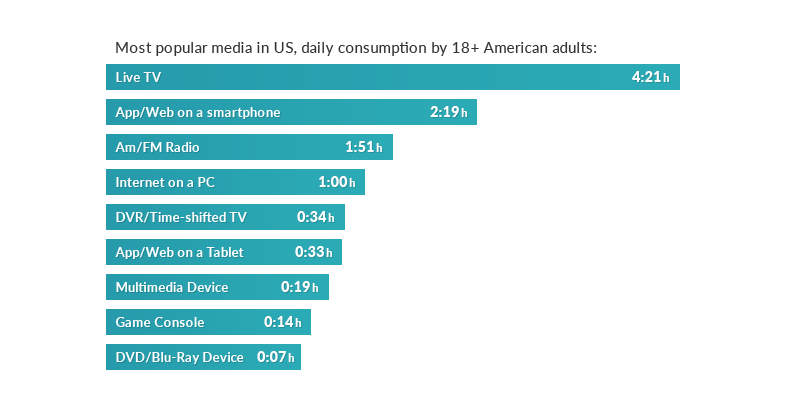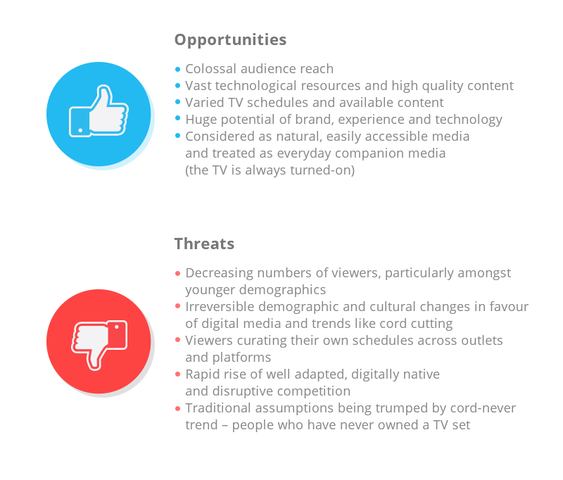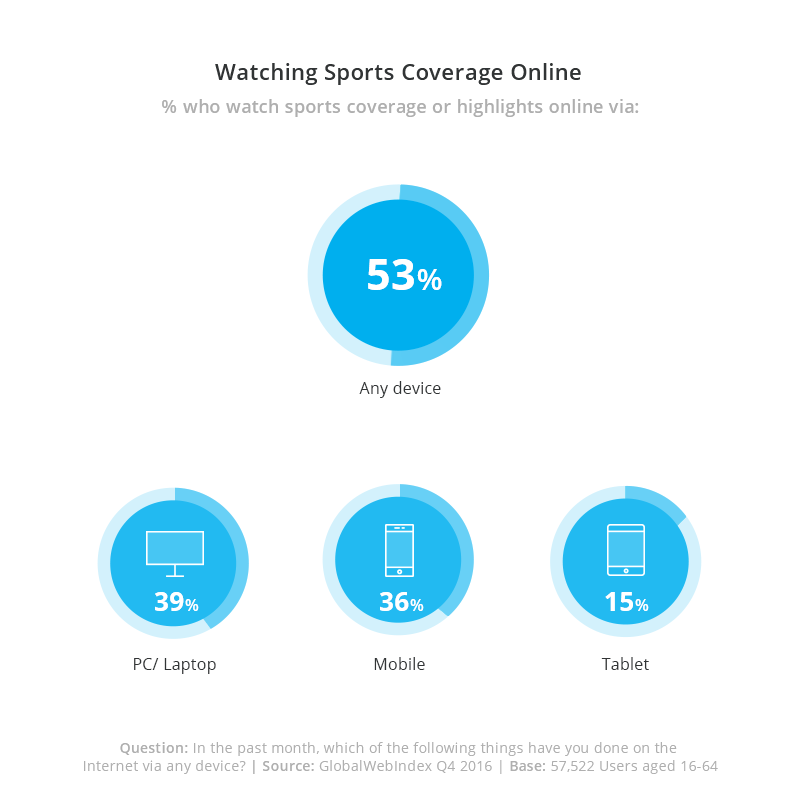Your essential read if you’ve ever wondered how to make traditional TV cool again!
In the US, adults are spending more and more time with different kinds of digital media[1], while their attention is also shifting from traditional TV to PCs, and smartphones and tablets connected to the web.
What’s interesting is that while there is an enormous variety of traditionally broadcast TV channels to choose from (a monthly average of 206 channels according to Nielsen research), US adults only actively watch 20 of them[2]. In other Nielsen data for US adults, while TV still rules people are using a broader range of devices for home entertainment, with apps and the web now hot on the heels of TV. The total time spent on other devices now outweighs time spent watching traditional TV.

If you look at the behaviour of younger viewers in particular, what’s evident is that Generation Z (12-20 year olds) consume the smallest amount of traditional TV, either when live or time shifted/recorded. Arguably, this is the effect of a new and younger audience becoming bored (or simply not accustomed to) traditional TV’s linear approach, which might be a challenging argument to accept if you work in broadcast TV.
To help you to understand, let’s look at this analogy. Nowadays, traditional TV is like a middle-aged guy trying to gain popularity on Snapchat – the technology feels the same, the rules are clear, but somehow it simply doesn’t work for him. What he says and does is simply not attractive enough for the audience on that platform. (Believe me, I feel like this guy at times as I don’t always understand the buzz surrounding Snapchat.)
Back in the broadcasting world, you may be more than conscious that new ways of consuming media are coming. You might feel they’re already here. Yet, with huge resources, varied schedules and all the broadcasting technology at your disposal, perhaps you’re still left wondering why traditional TV isn’t as attractive as it was? Perhaps you can’t quite put your finger on why this is the case.
Let’s take a closer look at some of the opportunities and threats below.

What’s common amongst the above threats is the impact of the internet and the smartphone. Viewers now have more flexibility – they can watch and interact with digital, web TV and OTTs in any manner they like, where and when they want, and on the device of their choosing.
Why should viewers miss the ol’ set-top box? So, is this the end of linear TV as we know it? It’s too early to jump to this kind of conclusion. For sure, there are now many more options to traditional TV and improvements that linear broadcasters should make to stay in the game.
Let’s dive in and check out six ways you can sharpen your focus to stay alive in this fast-paced, digital-first world.
- Make the web your friend and ally
- Use your TV brand as leverage
- Your experience is your advantage
- Retain your loyal viewers
- Work across platforms
- Conversations – it takes (at least) two to tango!
First things first, if you haven’t done so already, make your brand more visible online by expanding your social media presence. Take time to reconsider your options, making an audit of your efforts to date to identify what’s worked and what hasn’t.
When relaunching your social media presence, have a video content strategy in place that puts you in a position to start streaming and producing videos for social channels. Streams and social videos make for highly engaging web content and, as a broadcaster, you are ideally placed to create a constant stream of such content. To do so, choose social video production tools and platforms that will fit your needs, and ones that will enable you to stream and produce videos from live content and any archival content you want to use.

Live streams and videos are undoubtedly the most engaging types of content. When checking Facebook streaming results for one of our Tellyo clients, we learned that it is possible to create up to 400 interactions per 1,000 fans with live video, while images were able to reach only 6 interactions per 1,000. For further interesting stats, check out the case studies section on our website.
Having a strong and recognisable brand is unbelievably helpful online – it will help you to stand out. If your logo is well known, you should remember to place it on your video content, so that when this spreads around the internet you get the brand recognition you deserve. With a little bit of luck, many viewers will trace your quality content back to your channel or Facebook page.
Being experienced with video production and everything broadcasting related is a huge advantage over your competitors. Being able to create TV-grade video content, while having an experienced team and professional equipment are all strong assets. However, these assets aren’t enough to be successful on the web and in the social media, but they will help a lot. You can always talk to us here at Tellyo about how to combine your experience with an advanced, social video production platform such as ours.
Have you ever heard of the Pareto principle[4]? Better known as the 80/20 rule which states that 80% of the effects come from 20% of the causes. Translating this into broadcast language – it means that 20% of your audience is responsible for 80% of your views. Therefore, if you want to be successful in social media, play to your core audience. Let them know that soon they will be able to watch their favourite shows and events via other media as well.
Remember that social media isn’t monolithic – it’s decentralised and each platform has its own properties. You shouldn’t copy and paste your strategy from one channel to another. For example, if you decide to stream content then use YouTube, Facebook or Twitter, but only YouTube will be a good place as a platform to host clips for a longer period. Facebook will give you a big audience and visibility initially, but people will not find your videos once they vanish from timelines.
Your audience has a voice, and it will use it. In comments, emails and chats, they will use each possible channel to give you their opinion about your content. And that’s a good thing – a gold mine of interactions and engagement to treasure. You should work hard to maintain these conversations. Be active: answer questions and ask for opinions.
It’s too early to abandon ship
Traditional, linear TV still has a lot to offer audiences. But the TV landscape in the next 5-10 years will be dramatically different to what we have now.
In the meantime, there is likely to be many more advances and disruptive changes. Now is your chance to decide whether you want to be part of it or not.
5 sports clubs keeping fans excited with creative video content
Sports fans are a unique bunch. They consist of people able to name an entire trophy-winning team from back in the 60’s, to the sort willing to go to another continent to see their team, sometimes in the knowledge they could get heavily beaten.
Thanks to the development of the web, the last 15 years have enabled the most popular clubs to get closer to many new fans – now only a click away. However, the majority of these new fans might never get a chance to see their favourite team in person. This situation is making club owners and marketing managers face a new challenge: how to maintain the interest of millions of fans who are living thousands of miles away? These fans are often unable to visit the stadium to see games or watch on TV, while just selling merchandise to them is far too short-sighted as a strategy.
Interesting read: Reach new fans by going social
To nurture fans, and keep them engaged and committed, surely you need to give them something more? The answer for many clubs is to make all fans across the globe feel like part of a wider community. But how? This is when creative video content and social media come into play!
In this blog, I’ll walk you through the best examples of video content produced by some of the most popular sports team in the world. But, before we start, let’s find out…
…how are fans consuming sports content?
The stats tell us that 53% of global internet users watch sports coverage or highlights. That’s a tremendous amount of people – with 39% choosing PCs and laptops to see their favourite teams plays; while 36% watch on mobiles and 15% on tablets[1].

It’s pretty obvious that internet users worldwide are looking for sports content and using a range of devices to do so. So, it’s worth adjusting your content to fit different screen sizes, as well as the aspect ratio requirements of each social platform.
Right, let’s now look at some cool examples of unique content, created by popular sports clubs.
AS Roma (Italy, Serie A)
The Italian football club from Rome is well known around Europe. But their fan base is smaller than other, top-notch clubs like Real Madrid or Chelsea. However, their efforts to create a comprehensive club TV channel is impressive. It’s well worth a mention here.
AS Roma offer their own traditional TV channel, but it is also available through their website for fans outside of Italy. It provides info about daily life at the club – training updates, chats with guests, replays of historical games and a frequent look back at the club’s legendary players. Live broadcasts run from Monday to Saturday in the morning.
Roma also offer a paid, premium version – called Roma TV+. It includes live video content, national and international games, and an on-demand service featuring past games and highlights.
Overall, the club has put in a lot of effort to make their fans well informed about the club and everything going on around it. Even the youth section has its own, dedicated programme – Punto Giovani. You can see that content produced for Roma fans is top quality, with programme specials often involving players as hosts and guests.
New England Patriots (United States, NFL)
While the NFL is huge, its broadcasting deals are complicated. For example, not all games are broadcast nationally on TV. Usually, there’s only one game shown nationally in each set of games – on Thursday, Sunday and Monday nights. The rights to stream games in the current season have been signed by five linear TV channels. At the same time, these channels are streaming games through the internet thanks to their paid platforms. Because of these licenses, clubs don’t have ready-made match content to show to their fans and can find it extremely hard to keep fans updated as a result.
Despite the above, the New England Patriots have really upped their game. Through their official website and YouTube channel they show video content such as game highlights, press conferences, and interviews with players and coaches. Videos are largely produced by external broadcasters, not by the club itself. However, the club’s YouTube channel is its home for in-house produced content, with Patriots players often playing an important role.
Fans get to see many humorous and interesting programmes involving players, such as visits to hometowns or lessons in game tactics.
The Patriots is a great example of content produced on an in-house budget but with great production values and interesting stories to tell. Fans can meet their idols and learn about their interests. This way, the New England Patriots are keeping their fans engaged with the club and its players, not only during games.
FC Barcelona (Spain, La Liga)
FC Barcelona is probably the most popular club in the world (sorry Manchester United!). While this is great news for the club, it presents a challenge to keep global fans interested all the time.
Obviously Barcelona games are more accessible – such as La Liga, Copa del Rey, Champions League, abroad tours etc – all of which are more widely broadcasted by many TV stations and digital broadcasters. The club itself also produces tons of its own video content. What’s worth of mentioning is that this content is not only dedicated to the first team.
You can see women’s games in the Spanish and Champions League, second team training sessions and youth academy football via the La Masia complex. Also shown are Barca fans having fun during matches, interviews with players and lots of Lionel Messi!
Barca also use YouTube to broadcast various events, like games involving the Barca Legends (a joy to see Ronaldinho, Kluivert and Rivaldo playing together!), as well as club updates such as contract renewals by key players.
The YouTube channel is updated frequently and loaded with action. While it’s unable to stream premium content because of broadcasting deals, the Barca media team do an amazing job and still have plenty to show. And fans around the world love it!
Boston Celtics (United States, NBA)
The Boston Celtics are the most successful team in the history of the NBA, responsible for 24.3% of all championship titles[2]. While the Celtics are unable to stream games to its Facebook feed or YouTube channel – because the rights are reserved for premium, paid services – they still have a lot to show.
The Celtics host video content on their official website, YouTube channel and Facebook page. Even though there are no live games, you can find a lot of action, highlights and interviews with players, straight from the pitch. However, this is what most teams are doing, so what Celtics content really stands out?
Specifically, the Celtics offer a lot of videos to promote their activity amongst its community of supporters. They help veteran soldiers, and promote health and fitness among its youngest fans. This is a great way to show that the NBA team is not only about money, contracts and breaking records, but it has strong community links built around the club.
However, my favourite type of Celtic’s video is the one called ‘Bad jokes’. It’s a simple format that shows paired players telling each other bad jokes! It’s completely silly, but at the same time just nice and refreshing to see professional sportsmen having fun. Priceless!
Canadiens de Montréal (Canada, NHL)
Because the NHL’s streaming rights – just like the NFL or NBA – are usually reserved for the biggest players in broadcasting, the league’s clubs tend not to produce content of their own. Most videos from popular NHL teams are just interviews or highlights – which is cool. But Canadiens de Montréal are different!
Someone in the Canadien’s video production team obviously has a lot of great ideas on how to involve players and bring some quality to their content. Despite the lack of game action and highlights, their YouTube channel is an extremely engaging place. They’re using multiple and diverse formats to reach their fans, and it’s working – they have the biggest number of YouTube subscribers amongst all NHL teams.
So, what’s so good about the Canadien’s video content?
If something seems crazy but it’s working – it’s not so crazy!
Sports video content is not only about the games!
There’s no doubt fans watch games for the thrill and emotion of live action – the scoring of a goal or winning a game. But there’s still a lot to show outside of the games. Digital platforms like YouTube or Facebook are perfect to show content aside to a club’s more formal digital roadmap.
A richer array of content can help larger clubs to build a positive PR image, increase reach, monetise viewership independently from major broadcasting contracts and keep the community up to date with club life.
Similarly, content produced by smaller clubs can draw in new fans, nurture an existing fan base and monetise digital content. Perhaps this sort of content will be a first in their history for many smaller clubs.
No matter how big your club or organisation, having this kind of video content will offer an amazing addition to current live broadcasting arrangements and existing marketing activities. Simply take look around your environment and explore interesting things going on. I bet there’s a lot of cool content you can learn from and begin to show yourself!





